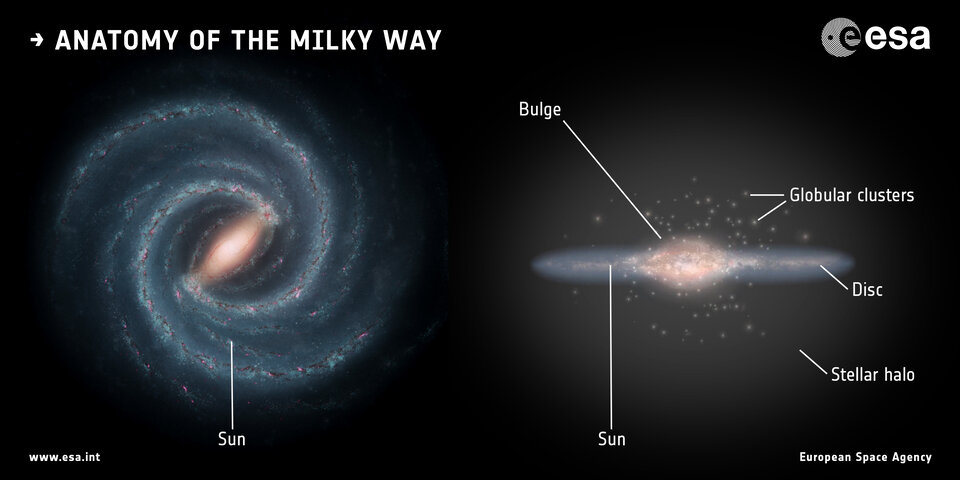Our galaxy’s stellar halo is giving astronomers some new food for thought. It turns out everyone thought the halo was spherical. But, it’s not.
That’s news to everyone who said it was spherical. According to a new measurement done by a team at Harvard-Smithsonian Center for Astrophysics, it has a tilted, oblong football shape. This all tells astronomers an interesting tale about our galaxy’s ancient history.
An artist’s concept of our warped, tilted galaxy stellar halo. Melissa Weiss/Center for Astrophysics | Harvard & Smithsonian “The shape of the stellar halo is a very fundamental parameter that we’ve just measured to greater accuracy than was possible before,” said study lead author Jiwon “Jesse” Han, a Ph. D.
student at the Center for Astrophysics | Harvard & Smithsonian. “There are a lot of important implications of the stellar halo not being spherical but instead shaped like a football, rugby ball, or zeppelin — take your pick!” So, is it a big deal if it’s not like a beach ball, as astronomers predicted for so many years? Well, yes it is. It turns out the odd shape is an important clue to Milky Way’s early history.
“The tilt and distribution of stars in the stellar halo provide dramatic confirmation that our galaxy collided with another smaller galaxy 7-10 billion years ago,” according to Han’s co-author Charlie Conroy. Anatomy of an Ancient Collision The evolutionary history of the halo around the Milky Way involves some interesting characters. First, there’s a strange, lonely dwarf galaxy that astronomers dubbed “Gaia-Sausage-Enceladus” or GSE.
The name comes from the European Space Agency’s Gaia spacecraft. The second part comes from the shape of GSE in its datasets. Finally, Enceladus comes to us from Greek mythology.
He was a buried, mysterious giant, much like GSE was hidden in Gaia data. Billions of years ago GSE collided with the Milky Way. Collisions are a natural way to build big galaxies out of small ones, and our galaxy formed that way.
That mashup tore GSE to shreds and scattered stars from both galaxies into a dispersed halo surrounding the galaxy. The interactions between the two also caused pileups of stars in the halo. That changed the shape of the halo significantly.
And, since GSE came in at an angle, the collision also tilted it. The amazing thing is that the shape is still odd and offset. Artist’s impression of debris of the Gaia-Enceladus galaxy.
Gaia-Enceladus merged with our Milky Way galaxy during its early formation stages, nearly 10 billion years ago. Its debris can now be found throughout the galaxy and in the stellar halo. Courtesy ESA.
You would think that after billions of years, the halo would have “sphericized” itself. Yet, the stars remain in this weird triaxially shaped “cloud”. Something else—which turns out to be dark matter—is at play, according to Charlie Conroy.
“The tilted stellar halo strongly suggests that the underlying dark matter halo is also tilted,” he said. “A tilt in the dark matter halo could have significant ramifications for our ability to detect dark matter particles in laboratories on Earth. ” That’s interesting to scientists searching for dark matter.
If there really is a tilt in the dark matter halo, there could be areas where this mysterious stuff is more concentrated. Finding those regions could give astronomers a chance to detect interactions with dark matter. This would be particularly interesting as Earth moves through them in the future.
More about the Stellar Halo The Milky Way isn’t alone in having a halo. Every galaxy has one dominated by dark matter. While we don’t see dark matter, it provides a framework for the distribution of ordinary, visible matter.
That includes stars, clusters, and nebulae in the body of the galaxy, plus stars in the halo. According to Han, the starry outer “shells” are important targets for observation. “The stellar halo is a dynamic tracer of the galactic halo,” he said.
“In order to learn more about galactic haloes in general, and especially our own galaxy’s galactic halo and history, the stellar halo is a great place to start. ” To tell the story of the Milky Way colliding with GSE, the team studied two major astronomy data sets. That allowed them to make a computer model of what happened.
One came from the GAIA spacecraft, which measures the positions, motions, and distances of millions of Milky Way and halo stars. The other data set came from a ground-based survey called H3 (short for Hectochelle in the Halo at High Resolution). The combined results showed the weirdly tilted football shape emerged almost immediately.
The team’s work will eventually help them tackle astrophysical questions about the Milky Way. “These are such intuitively interesting questions to ask about our galaxy: ‘What does the galaxy look like?’ and ‘What does the stellar halo look like?’,” said Han. “With this line of research and study, in particular, we are finally answering those questions.
” The Tilt in our Stars: The Shape of the Milky Way’s Halo of Stars is RealizedThe Stellar Halo of the Galaxy is Tilted and Doubly Broken The post The Milky Way’s Stellar Halo Isn’t a Sphere After All appeared first on Universe Today. .
From: universetoday
URL: https://www.universetoday.com/158758/the-milky-ways-stellar-halo-isnt-a-sphere-after-all/



